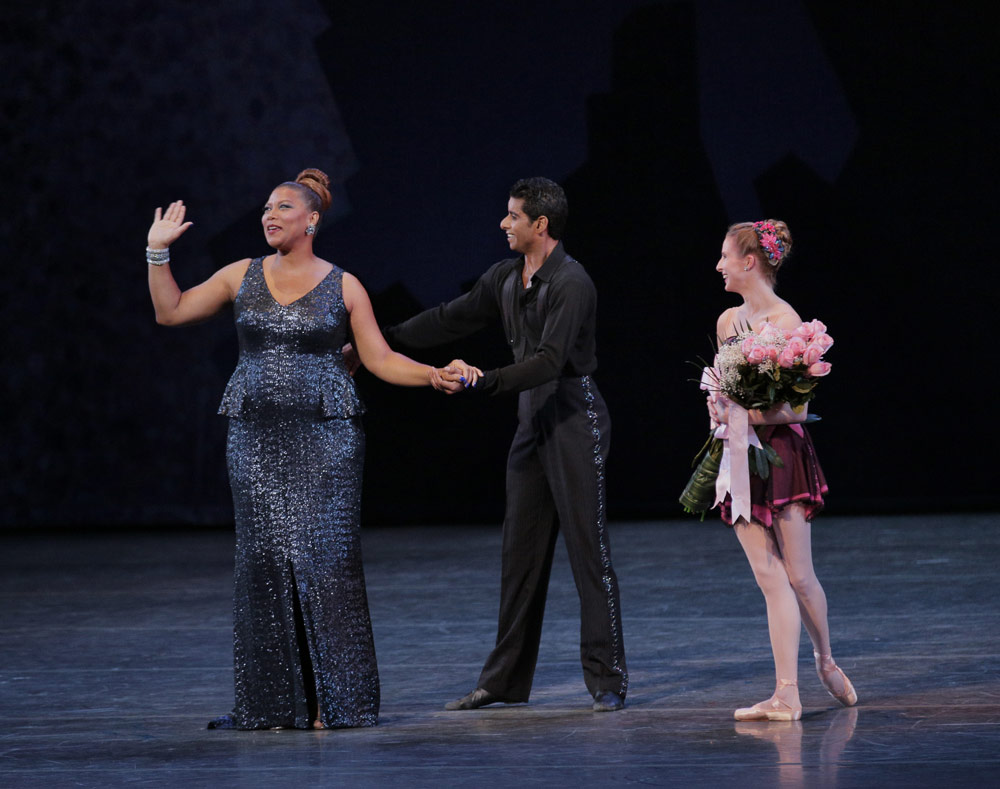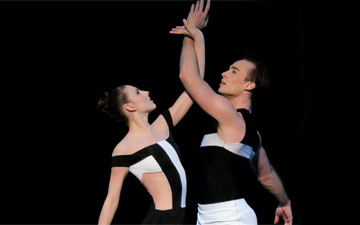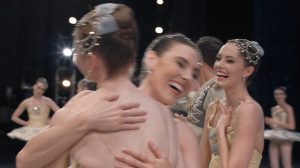
© Paul Kolnik. (Click image for larger version)
New York City Ballet
Spring Gala: Soirée Musicale, A Place for Us, Cool, Glass Pieces, The Man I Love, and Stars and Stripes
New York, David H. Koch Theater
8 May 2013
www.nycballet.com
A New Christopher Wheeldon Ballet Gala-Style
Another season, another gala. As these things go, New York City Ballet’s tend to be tasteful, efficiently-produced affairs. No speeches, no endless thank yous to donors and sponsors (all relegated to a bright red program pocket), and just one intermission. In accordance with the season’s American theme, all the music was American. A few tasty morsels were offered up to the be-gowned and tuxedoed set: First, a new ballet, by Christopher Wheeldon. Two starry musical guests: singer Queen Latifah and clarinetist Richard Stoltzman. And, complementing the new ballet, costumes by the young fashion designer, Joseph Altuzarra, about which, more later.
Considering the many distinctive works Wheeldon has given this company over the years (After the Rain, The Nightingale and the Rose, Polyphonia, Estancia, to name just four), a Wheeldon première inevitably brings raised expectations. His newest piece, A Place for Us, turns out to be an extended pas de deux for two of the company’s most musical dancers, Tiler Peck and Robert Fairchild. Both move with scintillating clarity mixed with a jazzy sense of all-American informality. Fairchild is a charmer, all heart, all energy and unending devotion to his ballerina. Peck is something greater: a dancer who exudes the kind of physical control that permits total freedom. Nothing is forced, nothing unfinished. In response to this quality, Wheeldon has created a dance that has the feel of an improvisation, as well as an homage to the artful spontaneity cultivated by Jerome Robbins in works like Other Dances and A Suite of Dances.

© Paul Kolnik. (Click image for larger version)
Another predecessor comes to mind: Balanchine’s Duo Concertant. Two dancers listen to the musicians playing onstage and then, as if inspired by the music, begin to move. The dance is a spontaneous meditation on the music, but also a reflection of their relation to each other. Wheeldon accomplishes this effect marvelously well. The music, which consists of passages from two sonatas for clarinet and piano, by André Previn and Leonard Bernstein (in that order), were played with great beauty of sound and rhythmic playfulness by the clarinetist Richard Stoltzman and pianist Nancy McDill. The Previn is quiet, introspective, constructed for the most part out of three notes. And these dancers really do respond to the sound – they listen, they react. The phrases tumble out of them, as in a private game, invented on the spot. The arms figure prominently, creating a sinuous counterpoint to the legs, painting calligraphy in the air. When the two dancers interact, the contact is initiated by Fairchild; he reaches here, there, as if trying out new ways of engaging his partner. He hooks her over his shoulder, with her chest facing back. The shape is ungainly, but they make it look like the most natural thing in the world. When the Bernstein sonata becomes more jazzy, they sway their hips, clap, and hold out their arms, a clear hat-tip to Jerome Robbins. It’s a charming, sophisticated little dance.
The performance was marred slightly by a failure in the costume design. One strap of the flattering pale blue sundress designed for Peck by Altuzarra gave way in the final moments, causing the front to droop dangerously low. Though one assumes she was wearing another layer underneath, such an accident seems surprising, considering that the company has been creating well-designed costumes for over half a century. Can you imagine one of Karinska’s witty patchwork dresses from Stars and Stripes coming apart at its first performance? So far, it must be said that the company’s courting of fashion designers – Valentino last season, Stella McCartney for Ocean’s Kingdom – has produced rather unsatisfactory results. On a larger note, is it peevish to mention that, for all the sophistication of A Place for Us, I had hoped for something more substantial? Wheeldon has just finished creating a new Cinderella for the San Francisco Ballet, a tiny snippet of which was performed at a gala in New York on Monday. Why not make something important here as well? A Place for Us is essentially a lovely, well made pièce d’occasion, with neither the underlying thematic interest of Duo Concertant nor the stylistic flourish of Other Dances. It is difficult to imagine it coming alive with a different pair of dancers, or lasting very long in the repertory. I may well be wrong. But A Place feels like a bauble, not quite a jewel.

© Paul Kolnik. (Click image for larger version)
The other Wheeldon ballet on the program was a revival of Soirée Musicale, one of his very first works, made for the School of American Ballet in 1998 when he was still a dancer with the company. The music, by Samuel Barber, is a suite of dances – a waltz, a tango, a two-step, etc. – originally composed in 1953 for two pianos (Souvenirs). Subsequently orchestrated, it was used by Todd Bolender for a ballet in 1955. Each piece has its own character, and Wheeldon has responded in kind. Three couples waltz and flounce about in the opening number; two vapid, insistent women, reminiscent of Cinderella’s annoying sisters, vie unsuccessfully for attention in the “Schottische.” The cleverest episode is the tango, in which a single woman, Brittany Pollack, dances with a whole battalion of men, each of whom tries to sweep her off her feet like a pack of Valentinos in heat. It’s a tongue-in-cheek riff on those old Hollywood musical numbers in which a bombshell (Marilyn Monroe, say) is handled, lifted, and trailed after by a suite of handsome men in tails. Wheeldon has snuck in a little reference to Apollo near the end, when Pollack pulls three of her suitors across the stage, a reverse image of the young god with his three muses. Another ballet reference, to the wedding pas de deux from Sleeping Beauty, pops up in the swooning pas de deux. The lovely Lauren Lovette, who shows more assurance and spark with each performance, folds down to the floor and then is slowly pulled onto one pointe by her partner (the dashing Chase Finlay) in a great crescendo that ends with an image of radiance. The pas de deux, which opens with a series of plaintive lunges and backward-tipping arabesques, reveals another of Wheeldon’s nascent tendencies, that of peppering his partnering with complicated and innovative lifts, at times interrupting the flow. That said, Soirée is proof that Wheeldon’s playfulness, intelligent use of classical line, and love of balletic form, was there from the very beginning.

© Paul Kolnik. (Click image for larger version)
The rest of the program consisted of a medley of excerpts from familiar works. In Robbins’ “Cool,” from West Side Story Suite, the cast, led by Andrew Veyette, sang, snapped its fingers, and erupted into a series of jazz-inflected moves, urged on by Bernstein’s syncopated, explosive score. In the mostly-male section of Glass Pieces, Justin Peck led a pack of warriors, running and gliding across the stage, marking its ground with stomps and hops, in counterpoint to Philip Glass’s percussive rhythmic phrases. As always, one is struck by Robbins’ ability to create shifting patterns and his responsiveness to the smallest details in the music. The evening’s closing number, a crowd-pleaser, was an excerpt from Stars And Stripes, with Veyette as the vapid, self-important Capitán – a role he embraces with great flair and more than a touch of irony – and Ashley Bouder as his peppy, high-stepping gal. They brought down the house.

© Paul Kolnik. (Click image for larger version)
That leaves the other gala highlight, Queen Latifah’s star turn in “The Man I love,” from Balanchine’s Who Cares?. Latifah – or is it Her Highness? – gave a creamy, down-home rendition of Gershwin’s bluesy song. After a jittery start, clearly unused to following a conductor, she just went her own way, lingering here and there on a juicy note. The orchestra gamely followed, and so did the dancers, Sterling Hyltin and Amar Ramasar. It’s a testament to this company’s sensitivity to music – and the dancers’ ability to listen – that it all went so smoothly. The lyrics, and Latifah’s sultry sound, added an extra layer of warmth, hiding some of the hokeyness of Hershy Kay’s orchestration. Hyltin and Ramasar, too, slowed things down, enjoying the pauses, stretching things out, toying with the playful, sensual undertones of the choreography. Maybe “The Man I Love” should always be performed with this way, gala-style.

















[…] Here’s my latest for DanceTabs, a review of New York City Ballet’s spring gala, which included a new ballet, a pas de deux by Christopher Wheeldon, and the revival of an older work, Soirée Musicale, as well as excerpts from Who Cares, Stars and Stripes, Glass Pieces, and West Side Story Suite. […]
As it happens, “Souvenirs” by Bolender is the very first ballet I recall seeing as a child at City Center. It was very funny, with Gay 90’s ish bathing costumes Years later, having no idea what it was, I shyly approached Mr. Kirstein and described it to him. Naturally, he identified it for me without hesitation.
What a wonderful memory! Have you seen Wheeldon’s?